Pipe organs and organ building
in the Northern Territory of Australia
by D.B. Duncan
Councillor, Organ Historical Trust of Australia
June 2008
NT Organs
St. Mary Star of the Sea
Roman Catholic Cathedral, Smith Street, Darwin
Residence of Michael Pfitzner
Darwin Symphony Orchestra
Introduction
Organ building in the Northern Territory has been hampered by three major factors:
- the remoteness of the region,
- the smallness of its population; and
- the tropical climate that creates difficulties for the organ builder.
Creating a pipe organ for climatic conditions has always taxed the skill of the organ builder and is often beyond the ability of builders more accustomed to milder climates. Quite apart from the extreme and prolonged heat and humidity of the tropics, there is also the devastating effect of cyclonic activity. This factor has been an important consideration in the supply of instruments to the northern regions of Australia.
Nonetheless over a sixty year period from 1938 there have been three pipe organs in Darwin, two of which were in service and one installed but removed before it became playable. At the time of writing, there remains only one pipe organ in the Territory; the other two were removed in 1974.
All of the central churches in Darwin city are serviced by electronic instruments, at least two of which are sophisticated modern organs of high calibre and quality. Only one of these churches has ever had a pipe organ.
St. Mary Star of the Sea
Roman Catholic Cathedral, Smith Street, Darwin
1938 E. F. Walcker & Cie, Ludwigsburg, Germany

The organ and aboriginal choir c1960's
The first St Mary’s Star of the Sea church was built by the Jesuits in the 1880s, and was destroyed within a few years by a cyclone. A second stronger church to the same plan was then built. It became the first cathedral when Fr Francis Xavier Gsell, until then Apostolic administrator, was appointed the first Bishop of Darwin in 1938, but in fact the building was never more than a small church.
The pipe organ was built in 1938 by the major German organ builder E. F. Walcker & Cie, Ludwigsburg. Records of the organ are difficult to ascertain, because it appears the instrument was purchased through a Sydney broker rather than directly from the Walcker company, but it was originally thought to have been Opus 2649. This is probably not the case, as will be discussed herein.
This organ was erected in Darwin to commemorate the change in status of the church to a cathedral. The old cathedral building was later demolished and the organ relocated to the new (current) building in time for its opening in August 1962. The location of the instrument was high in the choir (rear) gallery beside the massive 16 meter high west window.
The organ had deteriorated and was restored in the early 1970’s by Rudolf Hoffman of Paderborn, Germany. It was publicly played for the first time since restoration at the Midnight Mass, Christmas Eve of 1974, the night Cyclone Tracy devastated Darwin.
Midnight Mass was being celebrated when the cyclone arrived, and water and wind caused significant damage to the church. While many people went home or elsewhere, some took shelter in the cathedral and spent the night of the cyclone there.
The organ was severely damaged when the large windows were destroyed by the cyclone. Parts of it were said to have smashed to the nave of the cathedral. Most of the wooden pews and sanctuary furnishings survived the cyclone and, restored/repaired, are still in use today. But the organ was never repaired for the church to use again. Nowadays a large electronic instrument services the needs of this busy church.
In the aftermath of the cyclone, the pieces of the organ were removed from the cathedral. The idea had been mooted that pipes would be scattered to various Northern Territory schools for science lessons on sound generation. Fortunately a technician in Darwin to restore communications heard about the proposed breaking up of the organ and he acquired it transported it to Adelaide. It was placed in storage and still remains unrepaired in an eastern Adelaide suburb.
Walcker Opus 2649 was reported to be of 2 manuals, 21 speaking stops and utilising electro-pneumatic action. This was a unit organ of probably 3 ranks extended to provide the sizeable stop list. However, photographs of the organ in the Darwin Cathedral clearly show a three-manual instrument and it may well have been another instrument, the construction of which was purported to have been cancelled, of 25 stops.
A similar instrument by the Walcker company, Opus 2637 also built in 1938, exists in the rear gallery of the St. Mary Magdelene RC Church, Rose Bay, New South Wales. A photograph of the Rose Bay organ can be seen in Historic Organs of New South Wales, G D Rushworth, 1988. p.333.
Gerhard Walcker-Mayer, Director of Walcker Organs, (Orgelbau Gerhard Walcker-Mayer) Germany, has attempted to retrieve Walcker archive detail of that era but is unable to. He has been supportive of the quest to identify and document the organ built by his forebears.
The current owner of the organ has not given permission to be identified and he does not have any immediate plans for the restoration of this unique and historic instrument.
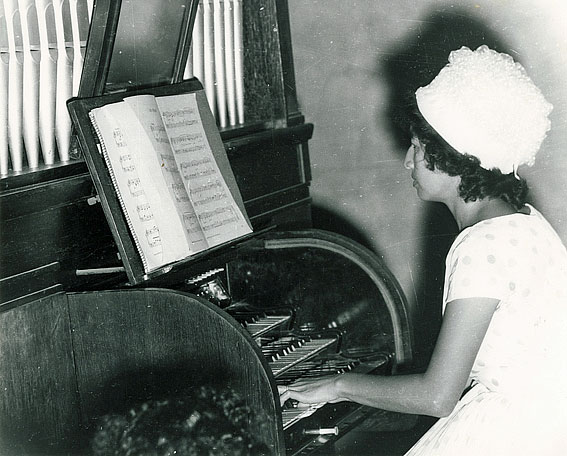
Detail of the console c 1960's
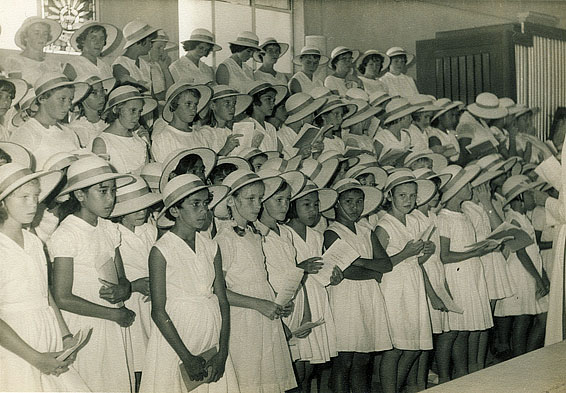
The choir and organ circa 1972.
In the west window (at rear) can be seen one of a series of stained glass panels showing the memorial character of the Cathedral.
These panels were donated by the Australian and American Armed Forces and depict emblems from their respective service arms.
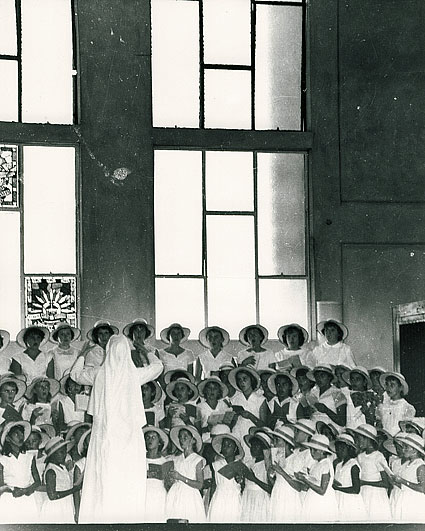
The choir and the edge of the organ case. More of the memorial window panels can be seen.
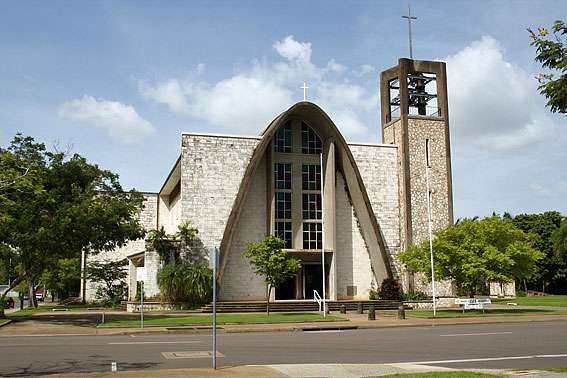
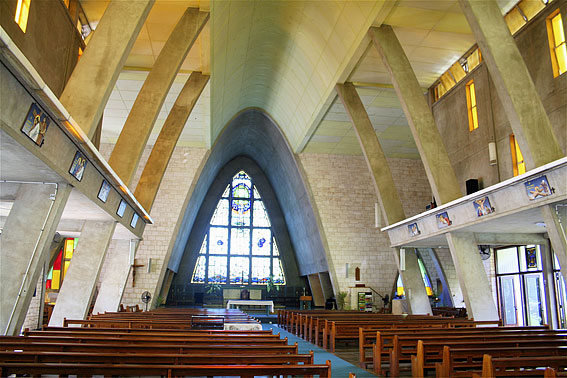
New Darwin Catholic Cathedral - March 2009 (Trevor Bunning)
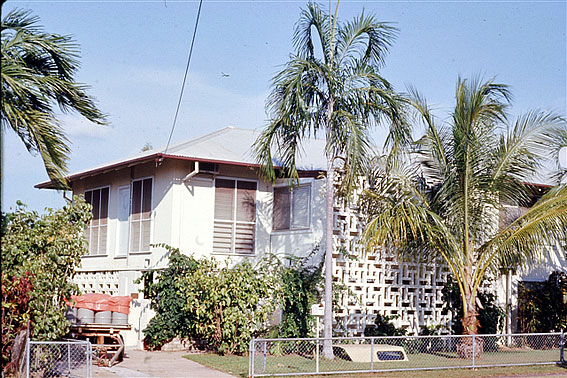
The Pfitzner residence in Douglas Road, Fannie Bay, at the time of the organ installation
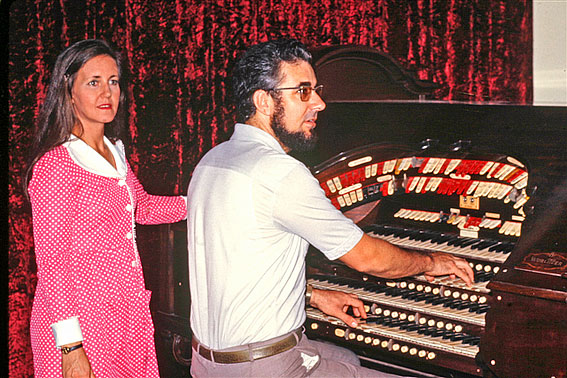
Val and Mike Pfitzner at the console, November 1974, before the organ was removed
Built in 1923 by the Rudolph Wurlitzer Company, North Tonawanda, USA, for the Wintergarden Theatre, Brisbane, QLD, this organ was actually installed by J E Dodd. It was originally configured as a 2 manual organ with 7 extended ranks of pipes using electro-pneumatic action.
J E Dodd was later responsible, in 1937, for the relocation of the organ to the Plaza Theatre, Sydney. At this time the tibia rank was added.
In 1956 the organ was sold to Penn Hughes of Bexley, NSW, where it was combined with parts of other organs—in particular a Christie organ from the Empire Theatre, Dunedin, New Zealand (the builders were Hill Norman & Beard, England and possibly their Melbourne branch), the Christie organ from the Burwood, NSW, Palatial Cinema (originally been installed in the Clou Conzert Haus in Berlin, Germany, and, later, parts were installed in the Seventh Day Adventist Church, Burwood) the Wurlitzer organ from the Burwood, NSW, Congregational Church (originally from the Kings Cross Theatre, Kings Cross, NSW, later at Savoy Theatre, Hurstville, NSW) and from the Conacher organ of the Regal Theatre in Southampton, England.
Then in 1967 the organ was sold again, this time to Michael Pfitzner, of Darwin. The organ was transported to Darwin by Michael Pfitzner in a double-decker bus and installed in concrete chambers in their Douglas Street, Fannie Bay, residence.
By this time the organ was of 16 ranks and controlled by the 4 manual Wurlitzer console that had been the "slave" in the State Theatre, Melbourne, Victoria.
The origins of the various ranks of the organ were:
Tuba Horn, Open Diapason, Clarinet, Viol d'Orchestre, Viol Céleste, Flute, Vox Humana - Wurlitzer, ex-Wintergarden, Brisbane (via. Plaza, Sydney)
Kinura - Wurlitzer, ex-King's Cross, Darlinghurst (via. Savoy, Hurstville and Congregational Church, Burwood)
Oboe Horn - Wurlitzer, ex-Regent, Wentworthville
Tibia, Melodia, Clarinet - Christie, ex-Palatial Theatre, Burwood, NSW
Viol, Orchestral Oboe, Vox Humana - Christie, ex-Empire, Dunedin, N.Z.
English Horn - Conacher, ex-Regal, Southampton, U.K.
The complexities of having such a large instrument in Darwin prevented the completion of the installation at the Pfitzner house and the organ was sold to the Theatre Organ Society of Australia, South Australian branch in 1974.
When the organ was purchased by TOSA, a six-person team from Adelaide went to Darwin in late 1974 and loaded the organ into a truck for transportation to Adelaide. At the time they had no idea of the urgency of their work, but within a month, Darwin was devastated by Cyclone Tracy on Christmas Day, 1974. Michael Pfitzner and his family were forced to take shelter in the empty area which had been the organ chamber, as their house collapsed around them.
The organ was installed at its present location, the Capri Theatre, Goodwood Road, Adelaide, in 1983. The organ initially had 12 ranks functioning when installed at the Capri. Over the following decade it gradually increased to 24 ranks, prior to a major enlargement completed in 1995 when it achieved its present 29 ranks controlled from a well-appointed 4 manual console. The stop list is endless, but the essential derivation of stops is based on the following:
Main: 16.16.8.16.8.8.8.8.8.8.16.8.8.8. Solo: 16.8.8.8.8.8.16.8.8.8.8.8.8.8. Stage: 16.
Organ Chamber Analysis
MAIN (Left Chamber)
16’ Open Diapason (Wurlitzer)
16’ Concert Flute (Wurlitzer)
8’ Flute Celeste (Wurlitzer)
16’ Gamba (Christie)
8’ Gamba Celeste (Wurlitzer)
8’ Viol d’Orchestre (Wurlitzer)
8’ Viol Celeste (Wurlitzer)
8’ Salicional (Wurlitzer)
8’ Voix Celeste (Wurlitzer)
8’ Tibia Clausa 12” (Dodd) rescaled
16’ Tuba Horn 10” (Wurlitzer)
8’ Trumpet (Trivo)
8’ Vox Humana (Christie)
8’ Musette (Trivo)
SOLO (Right Chamber)
16’ Tibia Clausa 15” (Wurlitzer)
8’ Solo String (Morton)
8’ Solo String Celeste (Morton)
8’ Quintadena (Stephens)
8’ Lieblich Flute (Wangerin)
8’ Horn Diapason (Meyer)
16’ Clarinet (Christie)
8’ Oboe Horn (Unknown)
8’ Kinura (Wurlitzer)
8’ English Horn (Trivo)
8’ Vox Humana (Wurlitzer)
8’ Harmonic Tuba 15” (Wurlitzer) revoiced by George Stephens
8’ Orchestral Oboe (Trivo)
8’ Saxophone (Trivo)
Chimes
STAGE
16’ Wood Diaphone (Independent rank)
16’ Tibia Clausa (Main Tibia extension)
Marimba-Harp
EXPOSED LEFT
Chrysoglott
Toy Counter
EXPOSED RIGHT
Xylophone
Glockenspiel
Sleigh Bells
Piano
PIPE COMPLEMENT
Main chamber 1,069
Solo chamber 950
Rear stage 57
Total 2,076 pipes
For a full specification and stop list of the organ, refer to the Theatre Organ Society of Australia South Australian Division website at: www.theatreorgansociety.capri.org.au/
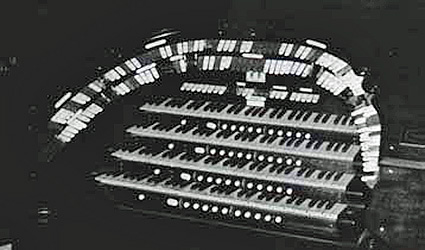
Detail of the organ console
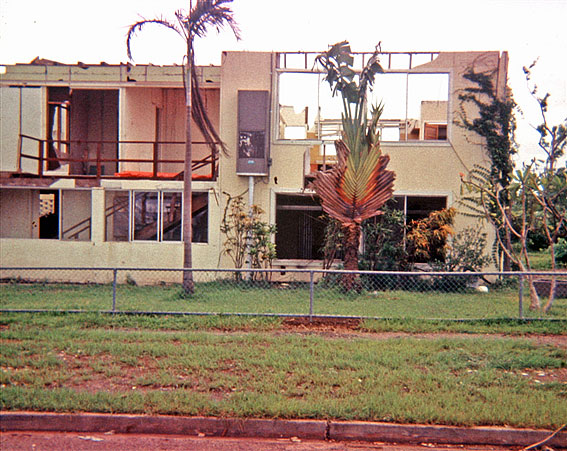
The Pfitzner residence, February 1975, showing damage from Cyclone Tracy
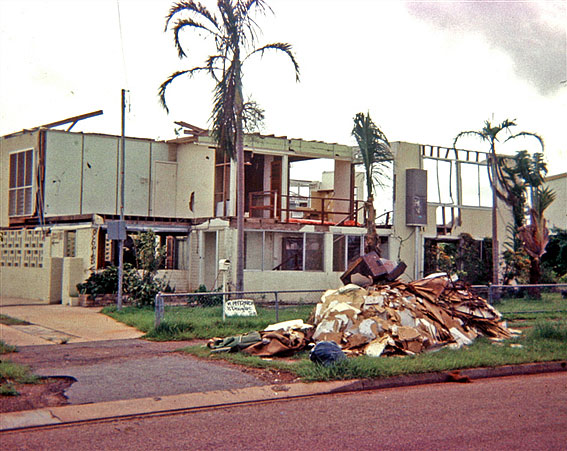
The Pfitzner residence, February 1975, showing damage from Cyclone Tracy
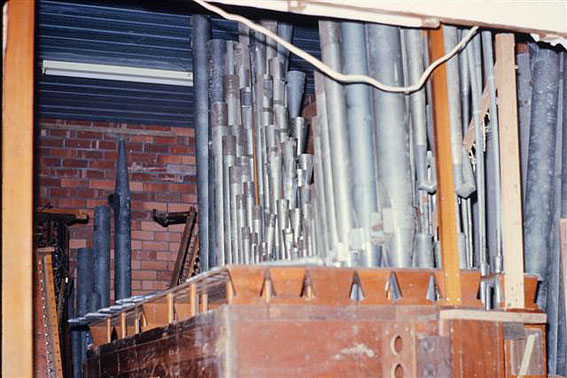
Pipework in the Pfitzner residence
![]()
Removal of the pipework in preparation for transport to Adelaide
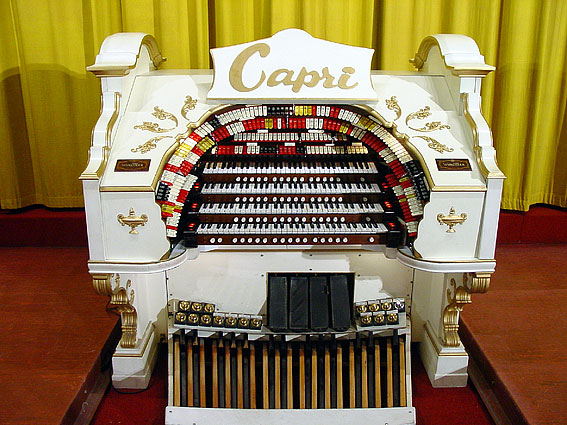
The organ console, Capri Theatre, Adelaide
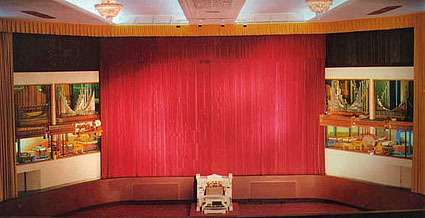
Capri Theatre stage - organ chambers are exposed left and right
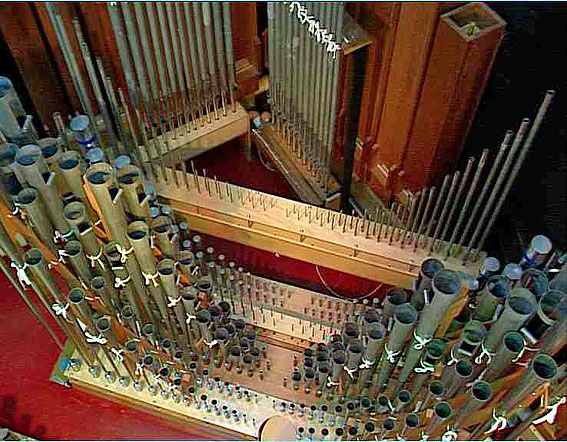
Pipework at the Capri Theatre
Photos: Wayne Bertram, Theatre Organ Society of South Australia, except for photos of the house which were taken by Malcolm Patterson.
Darwin Symphony Orchestra
1980’s George Fincham & Sons, Melbourne
1m., 4 sp.st., tr. Man: 8.4.2-2/3.2.
Located at the Charles Darwin University Performing Arts Centre, Rapid Creek Campus, Darwin, is the most recent pipe organ installed in Darwin, an organ originally built in 1980 by George Fincham & Sons Pty Ltd, Richmond, Australia, for the residence of Dr. Euan McLean, Canterbury, Melbourne.
It was removed, cleaned, regulated and relocated to Darwin in 1992 by Australian Pipe Organs Pty Ltd at the request of the Director of the Darwin Symphony Orchestra.
The organ has not been used since 2000 and currently sits in a storage room behind a xylophone and grand piano and, when I found it, a cello was shoved underneath it. It was not possible to fully examine the instrument.
The single manual is of 56 keys C – ggg and is stamped under the key rest KLAV 1. Key and stop action is mechanical. Natural keys are black wood overlay, sharps are white. An electric blower is located inside the casework.
STOPLIST:
| Stopped Diapason Rohrflote Principal Quint |
8 4 2 1-1/3 |
Wood except top 6 notes Metal Metal Metal |
The stops are activated by slide knobs located on the right of the keyboard and not labelled.
The Stopped Diapason is on a separate windchest with the lowest octave offset to the left of the main chest and situated in a separate section of the casework. The longest of these pipes are mitred to fit the dimensions of the case. The Quint was possibly made as a Nazard according to stamping on the actual pipes - it seems that Fincham’s often made stock Nazard ranks during this period and then the bottom octave left off and additional top notes made when it was fitted to one of their small organs. In this case it has been voiced as the Quint.
I was unable to properly assess the tonal capabilities of the instrument in a congenial ambience due to its location in the storage room.
The organ is very shrill, probably because of its design in the influence of the French-trained voicer and organ builder working with the Fincham company at the time of its construction, Michel Alcouffe. The organ was designed by Werner Bosch, a German organ builder and friend of George Fincham.
Darwin Symphony Orchestra has little interest in or use for the organ and may consider selling it.
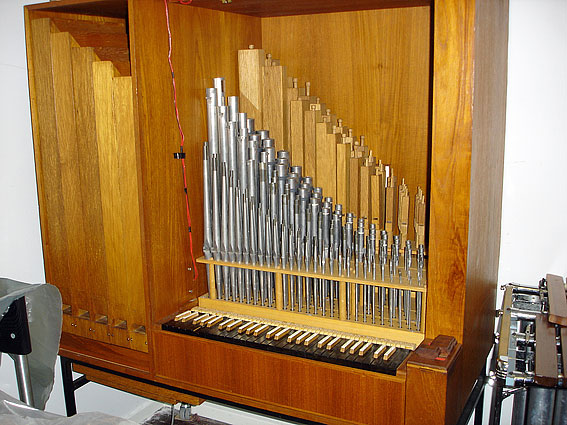
The organ with music rack and grille removed
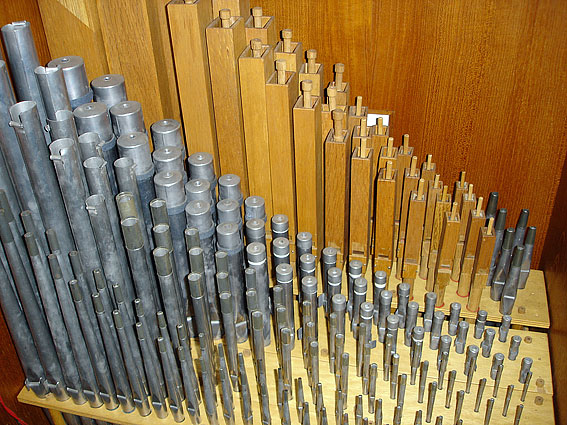
The main organ windchests
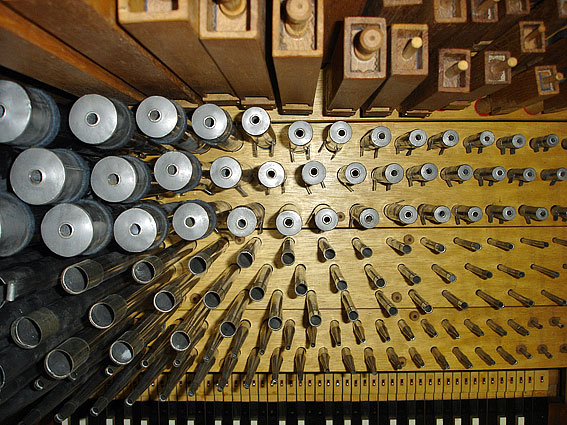
Looking down on the main windchests
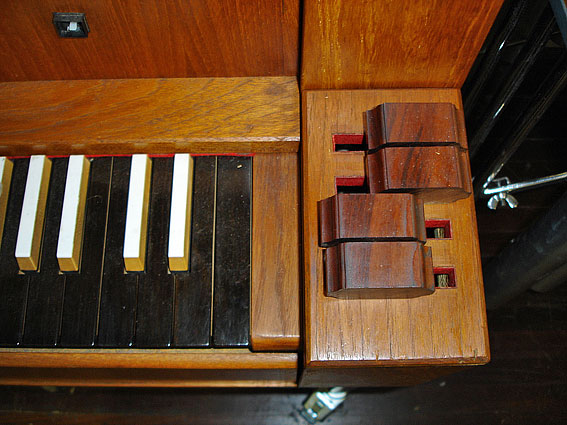
Stop knobs
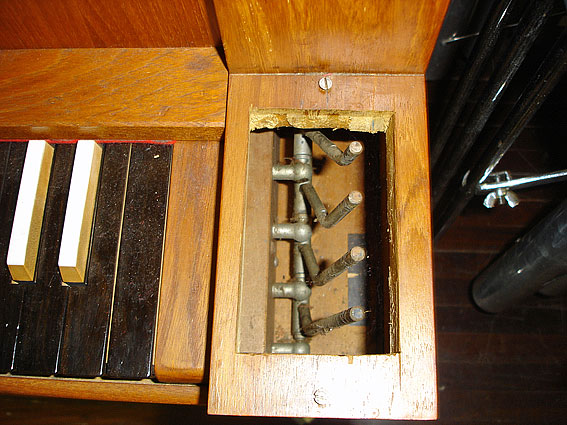
Stop mechanism
Photos: Bruce Duncan
Closing Notes
I am indebted to a wonderful group of people who have provided me with information for this article:
Gazetteer of Victorian Pipe Organs, J R Maidment, OHTA, 1970.
Gazetteer of New South Wales Pipe Organs, J R Maidment, OHTA, 1981.
Gerhard Walcker-Mayer, Director of Walcker Organs, (Orgelbau Gerhard Walcker-Mayer) Germany.
Robert Heatley, Australian Pipe Organs Pty Ltd, Melbourne.
Mr Bruce Lindsay, former Director, Darwin Symphony Orchestra.
Associate Professor Martin W B Jarvis OAM, Artistic Director, Darwin Symphony Orchestra.
Fr Stephen Hackett MSC, Catholic Diocese of Darwin.
Rod Blackmore and his Australasian Theatre Organs web site
Theatre Organ Society of South Australia web site and their members Wayne Bertram, Bernie Challen, and Ross Lange
Ian McIver and his Theatre Organs Under The Southern Cross web site
Perhaps the most interesting aspect of the project was to visit the places, see some of these people and to play the one remaining organ when I was in Darwin in August 2007.
Since that time the amount of correspondence about these organs from around the world has prompted me to commit what I have discovered to a format which can be published and, at the same time, preserved for the interest of others in years to come.
Bruce Duncan
